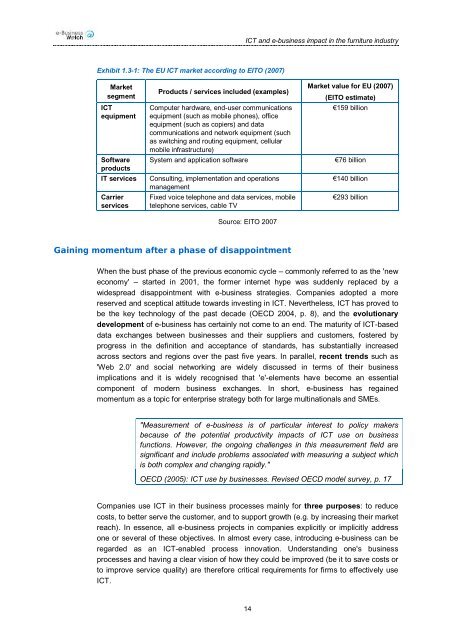ICT and e-Business Impact in the Furniture Industry - empirica
ICT and e-Business Impact in the Furniture Industry - empirica
ICT and e-Business Impact in the Furniture Industry - empirica
- No tags were found...
Create successful ePaper yourself
Turn your PDF publications into a flip-book with our unique Google optimized e-Paper software.
<strong>ICT</strong> <strong>and</strong> e-bus<strong>in</strong>ess impact <strong>in</strong> <strong>the</strong> furniture <strong>in</strong>dustryExhibit 1.3-1: The EU <strong>ICT</strong> market accord<strong>in</strong>g to EITO (2007)Marketsegment<strong>ICT</strong>equipmentSoftwareproductsIT servicesCarrierservicesProducts / services <strong>in</strong>cluded (examples)Computer hardware, end-user communicationsequipment (such as mobile phones), officeequipment (such as copiers) <strong>and</strong> datacommunications <strong>and</strong> network equipment (suchas switch<strong>in</strong>g <strong>and</strong> rout<strong>in</strong>g equipment, cellularmobile <strong>in</strong>frastructure)System <strong>and</strong> application softwareConsult<strong>in</strong>g, implementation <strong>and</strong> operationsmanagementFixed voice telephone <strong>and</strong> data services, mobiletelephone services, cable TVSource: EITO 2007Market value for EU (2007)(EITO estimate)€159 billion€76 billion€140 billion€293 billionGa<strong>in</strong><strong>in</strong>g momentum after a phase of disappo<strong>in</strong>tmentWhen <strong>the</strong> bust phase of <strong>the</strong> previous economic cycle – commonly referred to as <strong>the</strong> 'neweconomy' – started <strong>in</strong> 2001, <strong>the</strong> former <strong>in</strong>ternet hype was suddenly replaced by awidespread disappo<strong>in</strong>tment with e-bus<strong>in</strong>ess strategies. Companies adopted a morereserved <strong>and</strong> sceptical attitude towards <strong>in</strong>vest<strong>in</strong>g <strong>in</strong> <strong>ICT</strong>. Never<strong>the</strong>less, <strong>ICT</strong> has proved tobe <strong>the</strong> key technology of <strong>the</strong> past decade (OECD 2004, p. 8), <strong>and</strong> <strong>the</strong> evolutionarydevelopment of e-bus<strong>in</strong>ess has certa<strong>in</strong>ly not come to an end. The maturity of <strong>ICT</strong>-baseddata exchanges between bus<strong>in</strong>esses <strong>and</strong> <strong>the</strong>ir suppliers <strong>and</strong> customers, fostered byprogress <strong>in</strong> <strong>the</strong> def<strong>in</strong>ition <strong>and</strong> acceptance of st<strong>and</strong>ards, has substantially <strong>in</strong>creasedacross sectors <strong>and</strong> regions over <strong>the</strong> past five years. In parallel, recent trends such as'Web 2.0' <strong>and</strong> social network<strong>in</strong>g are widely discussed <strong>in</strong> terms of <strong>the</strong>ir bus<strong>in</strong>essimplications <strong>and</strong> it is widely recognised that 'e'-elements have become an essentialcomponent of modern bus<strong>in</strong>ess exchanges. In short, e-bus<strong>in</strong>ess has rega<strong>in</strong>edmomentum as a topic for enterprise strategy both for large mult<strong>in</strong>ationals <strong>and</strong> SMEs."Measurement of e-bus<strong>in</strong>ess is of particular <strong>in</strong>terest to policy makersbecause of <strong>the</strong> potential productivity impacts of <strong>ICT</strong> use on bus<strong>in</strong>essfunctions. However, <strong>the</strong> ongo<strong>in</strong>g challenges <strong>in</strong> this measurement field aresignificant <strong>and</strong> <strong>in</strong>clude problems associated with measur<strong>in</strong>g a subject whichis both complex <strong>and</strong> chang<strong>in</strong>g rapidly."OECD (2005): <strong>ICT</strong> use by bus<strong>in</strong>esses. Revised OECD model survey, p. 17Companies use <strong>ICT</strong> <strong>in</strong> <strong>the</strong>ir bus<strong>in</strong>ess processes ma<strong>in</strong>ly for three purposes: to reducecosts, to better serve <strong>the</strong> customer, <strong>and</strong> to support growth (e.g. by <strong>in</strong>creas<strong>in</strong>g <strong>the</strong>ir marketreach). In essence, all e-bus<strong>in</strong>ess projects <strong>in</strong> companies explicitly or implicitly addressone or several of <strong>the</strong>se objectives. In almost every case, <strong>in</strong>troduc<strong>in</strong>g e-bus<strong>in</strong>ess can beregarded as an <strong>ICT</strong>-enabled process <strong>in</strong>novation. Underst<strong>and</strong><strong>in</strong>g one's bus<strong>in</strong>essprocesses <strong>and</strong> hav<strong>in</strong>g a clear vision of how <strong>the</strong>y could be improved (be it to save costs orto improve service quality) are <strong>the</strong>refore critical requirements for firms to effectively use<strong>ICT</strong>.14
















